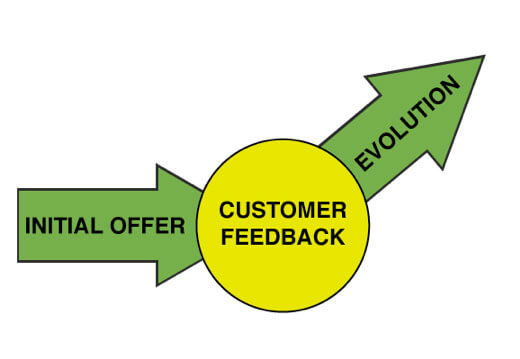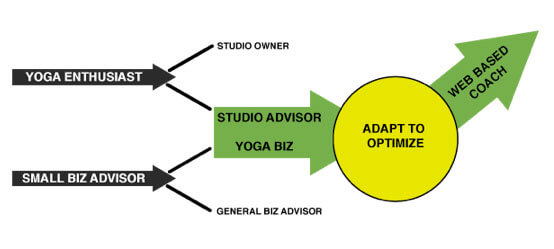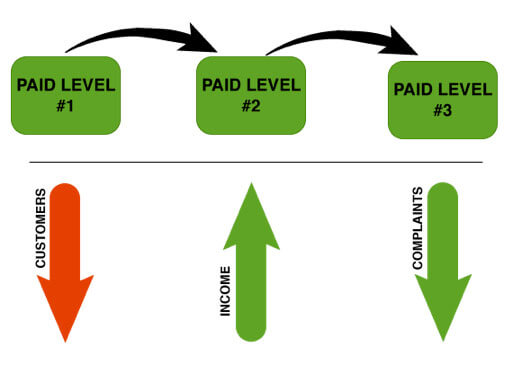One of the principle ideas of Smart Passive Income is that small changes can add up to big wins. For example adding an opt-in form to your About Page or simply finding the optimal price for your product.
These smart changes take just a few minutes but can lead to big time results.
Identifying the small tweaks that yield huge rewards is an extremely powerful idea, which is why I’m happy to host a guest post by Tyler Tervooren of Advanced Riskology and creator of The Bootstrapper Guild, who explores this idea and applies it to earning more money.
I’ve known of Tyler for a long time, but over the past couple of years we’ve become much better acquainted with each other through a fantasy football league and although we’re competitors during the NFL season, he’s definitely a top-notch player and friend in my book.
Please enjoy this incredibly powerful post from Tyler…
Everyone knows Charles Darwin’s theory: “survival of the fittest.” But most people understand it incorrectly. When we think of the fittest, we think of someone or something that’s superior right now. Whoever’s the biggest, strongest, and fastest wins.
But that’s not really what Darwin meant. Well, at least it’s not all he meant.
What Darwin was really talking about is the ability to adapt to change. If you’re able to take anything thrown at you and come out stronger, then you’ll survive in the long run.
I’m kind of a scrawny guy. If you stood a bodybuilder next to me, you’d estimate correctly that he could kick my ass in a heartbeat. But if you threw the two of us in a pool with cinder-blocks tied to our feet, that doesn’t matter anymore. Whoever grows a pair of gills first is now the real winner. Whoever adapts.
And so it is with life and money. It’s hard work to succeed over the long run; you have to adapt quickly when things aren’t working. If you’re a freelancer, this can literally be the difference between eating filet mignon next month or working like a dog to afford the “good” ramen.

Earning more money and enjoying your work is all about adaptation—the faster you do it and the more you commit to it, the better you become.
How to Evolve Your Income the Charles Darwin Way
In the natural world, we don’t have much control over evolution—it just sort of happens. But if you want to increase your income, you’re going to have to work at it. This means experimenting with different ideas that may or may not turn out the way you want them to and constantly testing and improving.
The ultimate goal is to find the smallest change with the greatest effect. In scientific terms, the “minimum effective dose.” Easier said than done. Often, the evolution you need to make to increase your income is one or two steps removed from the problem itself.
Let me give you an example. Think about someone trying to lose weight. The obvious solution is to eat less and exercise more, but how often does that actually work? That plan goes fine for about a week until you’re crazy hungry and your friend offers you some pie. The real solution is not to try to eat less pie, but to surround yourself with people who won’t offer it to you in the first place.
When it comes to evolving your income, you have to get creative and look beyond the surface. Let’s look at a business that made a minor change that drastically increased their speed of growth.
How “Putting it on an iPad” Created a $10 Million Business
Shopkeep is a little Internet startup that caters to local businesses looking for a simpler way to handle payments than a cash register and complicated sales systems.
For two years, the development team worked to build a solution that would make handling money easy for people who ran bakeries, coffee shops, corner stores, and other retail shops. And they created a great solution! Anyone who wanted to use their service could run their program from a Mac or PC to handle any kind of sale, and it was all managed and stored in the cloud.
But when Amy, one of the founders, described the early days to me, her words were, “We were doing ok, signing up a modest amount of customers…”
“Ok” and “modest” aren’t exactly words you’d use to describe a home run, right? But they had a great service, so what was wrong?
Talking to one their customers—a coffee shop owner—they learned that what was really needed was something even smaller and even simpler. The answer, to them, was obvious—an iPad app. Simple, completely portable. And creating it would be easy because the hard work was already done.

A month later they released it and the numbers started rapidly improving. Just a few months ago, they were given $2 million in financing to expand. When you put the numbers together, that makes Shopkeep about a $10 million company.
The pivot worked. And because small shop owners talk to each other, their customers do a lot of the heavy lifting when it comes to selling their new service.
I can personally vouch that the change worked, too; I’d never seen an iPad cash register before, but now I’ve seen three cafes in my neighborhood switch to their system in just the last few months.
Shopkeep found a way to take all the hard work they’d already done and move it to a new platform.
What small change can you make to capitalize on all the hard work you’ve already done? How can you adapt?
How a Yoga Enthusiast Added Six Figures to Her Business by Adapting to Change
Rachel Cook started her career in yoga like most others do—as an enthusiast. But the way she built her yoga empire was through a series of adaptations much different than most yoga professionals.
When she’d had enough of her corporate job (helping small businesses grow) she knew she wanted to do something with yoga. She could take a lot of training courses, become an instructor, and eventually open her own studio. But that would take forever and she didn’t even want to run a studio.
So instead, she adapted in a way that made more sense for her. She took the years of business advising she’d already done and focused in on other yoga instructors (who are great at what they do, but notoriously bad at running businesses).
This shift wasn’t just a shortcut, it also played on the unique experience she already had—no additional skills required. Taking the valuable skills and experience you already have and re-positioning them is a key factor to increasing your income quickly. There is absolutely no need to start over.
Pretty soon, Rachel was flying all over the country to meet with clients. Rachel had a serious business as the “yogipreneur” built around helping yoga instructors grow their studios.
Then she had twins and was faced with a difficult choice. Should she:
- Keep going at this pace and miss out on seeing her kids grow up? Or,
- Scale back and sacrifice her career to be “Mom?”
But Rachel saw this as a false dichotomy. Rather than choose to give something up, why not just evolve? She picked option three: move her business online where she could scale up, work from home, and spend time with her kids.
And this evolution hasn’t just benefited her with more time and a potential six-figure jump in income this year, it’s helped her clients who now have easier access to her and pay less for the service. Win/win.

One reason so many people think they have to start over is because the skills they’re using at work aren’t making them happy or they don’t feel “passionate” about what they’re doing. Nonsense. What this really means is that the skills you have aren’t being applied in the right places. You’ll feel plenty passionate when you adapt them into work that actually excites you.
Rachel used the momentum behind her to evolve into bigger and better things. Adapting doesn’t always mean completely changing direction. Just a small change can make a huge difference.
Chargify makes a great example of this point, too.
A 600% Increase in Income…Overnight
When Chargify opened in 2009, they had a grand idea that would change the way businesses made money; rather than rely on selling something new every month, now they could easily sell subscriptions and make money every month. It’s a full-scale business, but the lesson they learned applies to increasing your income no matter who you are or what you do for a living.
Chargify opened strong and had thousands of people sign up for their service. But there was a problem; everyone was signing up for free accounts and never upgrading. They were losing money!

Well, you can’t get away with losing money for long, so Chargify made the difficult choice to change one small thing in their business and stop doing work for free. The backlash from customers and even the press was fierce.
But what happened next is far more interesting: They started making money. All of a sudden, paying customers started to show up. From Michael Klett, co-founder:
“Ending our freemium model increased our revenue by nearly 600%, almost overnight. We lost some customers, but there was a large segment of our customer-base that wanted to pay us because of the value we brought to their business.”
And there was another added benefit: The number of customer complaints fell dramatically. Apparently, when you’re running a real business you’re more concerned about growing it than complaining about details.

Today, Chargify is profitable and growing. But if they hadn’t adapted when they did, there might not be a Chargify at all.
How to Evolve Your Own Income—3 Incredibly Important Questions
So how do you put this concept of adaptation to work in your own life? How do you increase your income by making a small change to how you work?
The answer is that, to get good results, you have to ask good questions. And you have to ask them before you make changes. Specifically, you need to be able to answer these three questions:
1. What problem needs to be fixed?
2. What’s the right adaptation to make?
3. How do I know the change is working?
Let’s say you’re a freelancer who makes cupcake deliveries to your neighborhood (a real business in my home town). Things are okay, but business could be a lot better.
Let’s answer those three questions for your confection venture.
1. How do I know it’s time to make a change?
This is going to start out vague, but then get a lot more specific. Obviously you want to change something because you’re not making enough money, but you need to zero in on why you might not be making enough money.
You think about it for a minute and come up with a few ideas:
- Ingredients are too expensive, but you don’t want to charge more and lose customers.
- Customers are too sporadic. You can’t plan out how much money you’re going to make.
- Delivery is too expensive and is eating up all your profit.
These are all things that could change (and probably should). Now you need to figure out exactly what to do about these problems.
2. What’s the right adaptation to make?
There’s no way to answer this question without testing. Since you don’t have a crystal ball, the best solution is to make a list of each thing you might change. Then—and this is very important—put them in order from easiest to most difficult, and start testing them one-by-one.
How could your confection service attack the problems you just listed?
1. Ingredients are too expensive.
- Buy cheaper ingredients and charge the same price.
- Charge more.
- Buy cheaper ingredients and charge more.
- Find a way to attract more customers and start buying in bulk to get lower prices for the same ingredients.
2. Customers are too sporadic.
- Ask for re-orders at the same time you make a delivery.
- Create coupons that give an incentive for quick re-orders.
- Start a subscription service and charge customers monthly.
3. Delivery is too expensive.
- Charge a delivery fee.
- Lump all deliveries together and only deliver on specific days.
- Cancel your auto insurance and use Zipcar for deliveries.
- Deliver by bicycle.
Now you have a list of action steps you can take to make real changes to how you work. Start with the simplest changes—the ones you can implement right away—and work your way down the list as necessary.
3. How do I know the change is working?
This is where things fall apart if you’re not careful. It’s easy to get excited and make changes, but there are two things you need to do to make sure you know with complete certainty which ones are actually working and which ones are wasting your time.
- Test only one thing at a time. If you make multiple changes at once, it’s incredibly difficult to tell what’s affecting what. When you make one change at a time, you know it either worked or it didn’t.
- Set a goal and a deadline for each change. Without these two things in place, it’s almost impossible to declare success or failure. When you have a goal, you either reached it or you didn’t. When you have a deadline, you either made it or you missed it. There’s no excuses—”Well, it looks like it’s making things better,” or “Maybe if I just give it a little bit longer…”
When you put these objectives in place, you can quickly test small changes and either keep them or dump them before moving onto the next one. There’s no guesswork.
Declare success or failure, and then begin the next test. Do this consistently and the successful adaptations start to compound. This is how you systematically improve your income.
The Bottom Line
When you try to increase your income, you’re not going to fail because you didn’t try hard enough. You’ll only fail if you’re not willing to adapt your plan when it isn’t working.
If you accept that you can’t run a business on autopilot forever and adjust to changes as needed, you can get through nearly any hardship. If you accept that uncertainty is part of the game and embrace it, then you’ll see problems early and react to them rather than bury your head in the sand.
Most importantly, you won’t lose hope and quit trying because you’ll know that just a few little changes can make an incredible difference.
Evolve early. Evolve often. Repeat. You’ll be glad you did.
What are 3 adaptations you can test this week to start increasing your income? List them in the comments below.
Do-It-Yourself entrepreneur Tyler Tervooren writes at Advanced Riskology, a site dedicated to living a better life through risk-taking. He’s also the creator of The Bootstrapper Guild, a program for DIY entrepreneurs to start their first micro-business.
 Tyler Tervooren
Tyler Tervooren
 R.J. Weiss
R.J. Weiss Chris Ducker
Chris Ducker John Corcoran
John Corcoran

